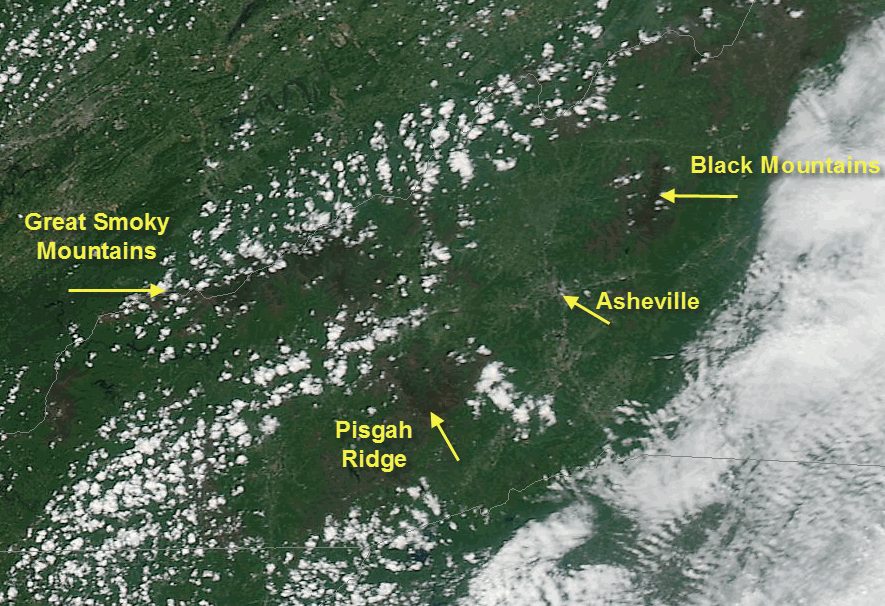From the Institute for Climate Education at A-B Tech: The forests that blanket Western North Carolina go through a yearly cycle of growth that can often occur unnoticed by most of us until we see the colorful displays of leaves in the fall … or have to fight the non-stop weeds of August. :-)
The ever-watchful eyes of NASA’s Earth Observing System can make it possible for us to appreciate this annual growth cycle from a new vantage point, thanks to the MODIS (or Moderate Resolution Imaging Spectroradiometer) instrument aboard the Aqua and Terra satellites.
The image below was taken this past Sunday (8/12/12) as Terra was passing overhead around 12:30 in the afternoon. The image shows the lush dark green forests of late summer, as well as some interesting features including key roads in the region.

Image Credit: NASA and the Space Science and Engineering Center (SSEC) at the University of Wisconsin-Madison.
You can also see an interesting fishbone-like pattern to the cumulus clouds west of Asheville. The clouds most likely formed along the higher peaks as the terrain heated in the sun, a common occurrence during the summer months.
If you’ve been reading these blog posts for awhile, you may remember the images below from The Greening of the Mountains post on May 3, 2012. These images from the Aqua satellite help to provide some perspective to this annual cycle of growth. The image below, from April 28, 2012, shows the bright greens of spring, with the exception of the higher elevations which still appear dark brown.

Image Credit: NASA and the Space Science and Engineering Center (SSEC) at the University of Wisconsin-Madison.
Those bright greens of spring are in sharp contrast to the late winter image below, from March 1 of this year that shows the still brown, pre-spring landscape.

Image Credit: NASA and the Space Science and Engineering Center (SSEC) at the University of Wisconsin-Madison.
Most of Western North Carolina has received near normal rainfall this year and the USDA Forest Service reports that our forests are generally in good health as a result. However, Jason Rodrigue, USDA Forest Service Silviculturist here in Asheville notes that the late-spring freezes that most of us endured this year may have a negative impact on the acorn crop both this year, as well as next.
(BTW, silviculture is a branch of forestry that deals with the development and care of forests. I had to look it up.)
If you would like to see a complete listing of the Fun Facts from the past, you’ll find the entire series on the Institute’s web site here.
Have a great weekend — and enjoy our beautiful forests!



Before you comment
The comments section is here to provide a platform for civil dialogue on the issues we face together as a local community. Xpress is committed to offering this platform for all voices, but when the tone of the discussion gets nasty or strays off topic, we believe many people choose not to participate. Xpress editors are determined to moderate comments to ensure a constructive interchange is maintained. All comments judged not to be in keeping with the spirit of civil discourse will be removed and repeat violators will be banned. See here for our terms of service. Thank you for being part of this effort to promote respectful discussion.